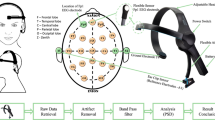Abstract
Multichannel measurement with hundreds of channels oversamples a curl-free vector field, like the magnetic field in a volume free of sources. This is based on the constraint caused by the Laplace's equation for the magnetic scalar potential; outside of the source volume the signals are spatially band limited. A functional solution of Laplace's equation enables one to separate the signals arising from the sphere enclosing the interesting sources, e.g. the currents in the brain, from the magnetic interference. Signal space separation (SSS) is accomplished by calculating individual basis vectors for each term of the functional expansion to create a signal basis covering all measurable signal vectors. Because the SSS basis is linearly independent for all practical sensor arrangements, any signal vector has a unique SSS decomposition with separate coefficients for the interesting signals and signals coming from outside the interesting volume. Thus, SSS basis provides an elegant method to remove external disturbances. The device-independent SSS coefficients can be used in transforming the interesting signals to virtual sensor configurations. This can also be used in compensating for distortions caused by movement of the object by modeling it as movement of the sensor array around a static object. The device-independence of the decomposition also enables physiological DC phenomena to be recorded using voluntary head movements. When used with properly designed sensor array, SSS does not affect the morphology or the signal-to-noise ratio of the interesting signals.
Similar content being viewed by others
References
Carbon, M., Wuebbeler, G., Trahms, L. and Curio, G. Hyper-ventilation-induced human cerebral magnetic fields non-invasively monitored by multichannel "direct current" magneto-encephalography. Neurosci. Lett., 2000, 287: 227–230.
Taulu, S., Kajola, M. and Simola, J. The signal space separation method. Biomed. Tech., 2003, 48, in press.
Uusitalo, M.A. and Ilmoniemi, R.J. Signal-space projection method. Med. Biol. Eng., 1997, 32: 35–42.
Uutela, K. Estimating neural currents from neuromagnetic measurements. PhD thesis, Helsinki University of Technology, 2001.
Uutela, K., Taulu, S. and Hämäläinen, M. Detecting and correcting for head movements. NeuroImage 2001, 14: 1424–1431.
Vrba, J. and Robinson, S.E. Signal processing in magneto-encephalography. Methods, 2001, 25: 249–271.
Author information
Authors and Affiliations
Rights and permissions
About this article
Cite this article
Taulu, S., Kajola, M. & Simola, J. Suppression of Interference and Artifacts by the Signal Space Separation Method. Brain Topogr 16, 269–275 (2004). https://doi.org/10.1023/B:BRAT.0000032864.93890.f9
Issue Date:
DOI: https://doi.org/10.1023/B:BRAT.0000032864.93890.f9




